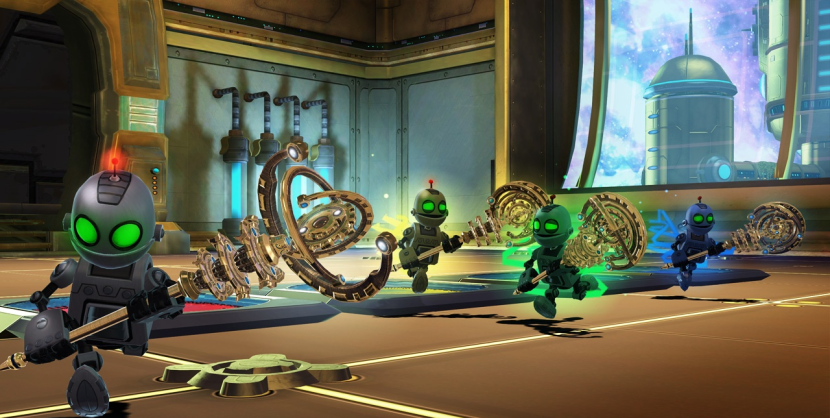The Ratchet and Clank series has been going since 2002, and from the first, the little duo has captured the hearts of platform gamers across the galaxy. The series has always primarily been about the insane weapons, and the dynamic duo afterwards. I’d go so far as to say that the series should ideally have been called Weapons of Ratchet and Clank instead. The latest game in the series, All 4 One, is now available, and adds a new twist to the game: 4-player local and online co-op. Does it work? Does it detract from the fun of the series? Let’s find out.
A game with a history like this cannot go unexplored, so in the interest of understanding my verdict about All 4 One, let’s first talk about the prior games in the series. The Ratchet and Clank series has a wonderful pedigree, and from the start has been serving us some of the most memorable characters and in-jokes in platform gaming; not bad for a series that’s already almost 10 years old. But let’s start at the beginning, shall we? The first Ratchet and Clankgame came to us in 2002 on the PlayStation 2, and starred the eponymous twosome; Ratchet, a cat-like creature—called a Lombax—with a penchant for gadgetry and pretty darned handy with a wrench; and Clank, a short robot who, for the purposes of both plot and gameplay, is able to shift forms in minor ways. Clank’s purpose was more than just as a foil for Ratchet, however, and, despite how little he featured gameplay-wise, was an important part of the duo. Initially, he was Ratchet’s less rash, more moral half, but as the series evolved, Clank became more of a needed companion than a conscience. The first game was highly praised; for the lively, memorable characters; for the imaginative environments; but first and foremost, for the weapons. The sheer number and diversity of the weapons that Ratchet attained was what made the game so much enjoyable fun, from the Pyrociter to the Bomb Glove to the Decoy Glove to the Tesla Claw to the good ol’ OmniWrench 8000. Heck, the sheer breakability of the environments allowed gamers just to forget about platforming for a while and just run around breaking things. True, the platforming wasn’t precisely brain-gym material, but then again, it’s a platformer. What did you expect? The cast were hilarious, the boss battles great challenges, and the game was just overall fun.
The second game, subtitled (depending on where you in the world you bought it) either Going Commando or Locked and Loaded, came out in 2003, and introduced a whole new set of new weapons, gadgets, and a new galaxy for the heroes to explore. In point of fact, the game took everything that was right with the first game, and upped it by a scale of about twenty-eight. Everything that was criticised about the first game was fixed, improved, and then upped by the same scale. The game was bigger, better, harder, with more to do, more to see, more to break, and more to collect. Not being just content with lots of insane weapons, the game added an RPG element to the weapons, allowing you to level them up with use. This gave some incentive to gamers to use some of the less effective weapons. The game also introduced spherical planets with different gravity systems, space combat, gladiator arenas, more weapons, and, as a way of saying thank you to those players who bought and played the first game, a way of importing some of the weapons from the first game, provided you retained the save file. It was brilliant fun, more memorable than the first for the changes they made, and possibly my personal favourite from the entire series.
As impossible as it may seem, a single year later Insomniac lifted the sky and placed it squarely on their own shoulders with Ratchet and Clank 3, also known as Ratchet and Clank: Up Your Arsenal. More weapons, including the disc blade gun, the lava gun, and the quack-o-ray! Bigger environments! A deeper upgrade system for the weapons! A new 2D side scrolling mini-game! More weapons, including mini-turrets and the plasma whip! More arenas! More gadgets and weapons, including a few from the previous games! Sadly, the environment was far less prone to breakage than Going Commando’s, but it was still fun to try and see what would break. Up Your Arsenal, quite importantly, also included a more than competent online multi-player component with three modes of play. Both online and offline modes were lauded and well received by game critics and the gaming public alike. Here was something truly extraordinary! A brilliant and fun online multiplayer game in 2004? Preposterous! And yet, here it was, and the online feature is what made Up Your Arsenal so completely memorable for many Ratchet and Clank fans.
Ratchet and Clank 4, also known as Ratchet: Deadlocked and Ratchet: Gladiator, forsook the brilliant weapons and environments, and ran with the multiplayer thing instead. Insomniac seemingly missed the point of calling the series “Ratchet and Clank”, and removed Clank from play altogether. The number of weapons got toned down, and the game took on a much darker turn than the previous three. Although Deadlockedwas still well received, many of the game’s fans found that it was not one of their favourites at all. Yes, there was now two-player local and online co-op, but all the elements that made the game the amazingly memorable experience was gone, and the series was all the poorer for this fourth incarnation.
The next major release of a Ratchet and Clank game would not arrive for nigh-on two years, for the PlayStation 3. In the interim, however, two smaller Ratchet games, Size Matters and Secret Agent Clank, appeared on the PSP and were later (poorly) ported to the PlayStation 2. Although they were minor games in the series, their events were still considered canon, despite the main protagonist in these games being Clank, rather than Ratchet. I have difficulty commenting about these two games, because they are the only two of the series that I have not personally played.
Everyone was looking forward to the Next Big One in the series, however, and in 2007, Ratchet and Clank Future: Tools of Destruction, the first game in the Future trilogy came to us in full HD, with bigger weapons, bigger gameplay, and more gloriously detailed environments. It was acclaimed as a glorious return to what made Going Commando [Ed: That’s Ratchet and Clank 2, for those of you failing to keep up here.] so wonderful, along with the number of side-missions, crazy upgradeable weapons, and beautiful planets to explore.
The next game in the series, Quest for Booty, released in 2009, was far shorter than the previous games, and once again left Ratchet somewhat Clankless. The game was available mostly as a download via the PSN; few regions saw the disc-based version of the game. The design team had not been idle between Tools of Destruction and Quest for Booty, though, and despite a number of the same weapons making a return from Tools of Destruction, the game had its own charm with better lighting, higher-resolution textures, new weapons, and new gadgets. Quest for Booty was far more puzzle orientated than the prior, more battle-focused games, and the gadgets in this game showed the new puzzle focus. Either way, however, it was meant to be nothing more than filler; a four-or-so-hour game meant to bridge that gap between Tools of Destruction and the next game. The new puzzle-focused gameplay made for a different balance in the game, however, and many players were of the opinion that the series was richer for it.
The next game, A Crack in Time, was released in 2009, and concluded the Ratchet and Clank Future trilogy. A Crack in Time introduced so many new game mechanics that it was hard to believe that it was the same series. In this game, Ratchet and Clank are separated for much of the plot, following two intertwined plot lines focused on the two characters’ respective fathers. The Clank sections, in particular, had an intensely heavy puzzle focus, some of which must have made the heads of more action-oriented players hurt a lot. Ratchet also gained a new ability to fly freely between planets and moons within a system, and the space combat was at the same time simpler, yet more engaging than the space combat in Going Commando. It was hailed as a brilliant conclusion to the trilogy, and a worthy specimen of the series.
Throughout each game in the series, the writers managed to maintain a level of in-jokes and humour that left the player guffawing, and the more games in the series you played, the better the in-jokes became. The humour, one could argue, was just as important a character as the weapons. If there was one thing you count on, it was awesome weapons and an above-average script.
The history lesson now over, the review proper continues on the next page.











2 replies on “We Review: Ratchet and Clank All 4 One”
Oh the nostalgia, that history lesson took me back. I have the same love for R&C as you do, and it’s a little disappointing that Insomniac took the route that they did with All 4 One (I dislike the title too).
An HD reworking of those PS2 classics would be awesome. Black Sheepinator FTW!
Nice review.
I have loved the R&C series.
But I feel a but scheptical about this one with its focus online gameplay. Seeing as I am internetless.
I know at some point I will cave and get it.